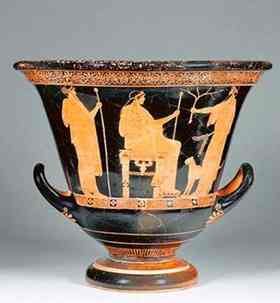Ancient theatre traditions are the focus of a novel exhibition at the 14th-century San Nicolo' Church in this eastern Italian city.
 The show offers visitors a behind-the-scenes look at the tradition of theatre-going in Ancient Greece and Rome.
The show offers visitors a behind-the-scenes look at the tradition of theatre-going in Ancient Greece and Rome.
Statues, mosaics, frescoes, props, lanterns and pottery are among the items on display.
Of particular note are 15 plaster masks discovered at the archaeological site of Pompeii.
On public show for the first time ever, these are displayed in a reconstruction of the workshop in which they were created and discovered.
Ritualized, exaggerated masks, used to depict stock characters, were critical given the massive scale of ancient theatres in order to ensure audiences of thousands could follow events on stage.
Archaeologists believe the plaster masks uncovered in Pompeii were probably used as moulds for much lighter, final versions made of linen, papyrus and cork.
There are also two bronze statues of Livia, wife of the emperor Augustus, which once adorned the theatre in the neighbouring town of Herculaneum.
The exhibition is divided into five different sections. The first looks at the theatrical motifs commonly found in Roman homes, particularly on pottery.
The second section focuses on the architecture and design of theatre buildings, created in Ancient Greece and later exported to Rome.
The popular comedies and tragedies, many of which are still studied and performed today, along with the main stock characters are spotlighted in the next two parts of the exhibition.
The final section examines the Greek good Dionysus and the origin of the theatre in Ancient Greece.
The Dionysia were key religious festivals celebrated in both cities and rural villages that centred on a performance of either a tragedy or, much later, a comedy.
The most famous Dionysia festival took place at the open-air Theatre of Dionysus at the foot of the Acropolis in Athens.
Over the decades, this staged the original versions of works by some of the most renowned classical dramatists, including Aeschylus, Sophocles, Euripides, and Aristophanes.
The exhibition wraps up with a small corner exploring the figure of Theodora, wife of the Emperor Justinian, who some sources suggested started out in the dubious profession of actress and dancer before later becoming the most powerful woman in the Byzantine Empire.
The exhibition, entitled 'Histrionica', runs at Ravenna's San Nicolo' Church until September 12.
Source: ANSA [August 04, 2010]















